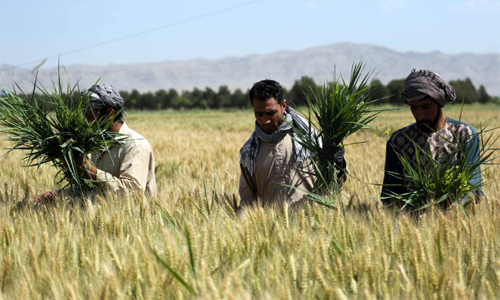The agricultural sector plays an important role in economy of Afghanistan as around 80% of Afghan populations are fed by this industry. The climate of Afghanistan is well suited for the cultivation of fruits, vegetables and multiple types of corns and other natural food though it faced ups and downs due to drought issues. Afghanistan is known for producing some of the finest fruits, especially apples, apricots, cherries, figs, grapes, melons, sweet mulberries, peaches, and pomegranates. Building and using greenhouses is a fast-growing industry the in country, especially large cities such as Kabul, Heart and Northern provinces. The Northern provinces are famous for pistachio cultivation, but their melon and water melon are unique within country or beyond. Provinces in the east of the country are famous for pine nuts. The northern and central provinces are also famous for almonds and walnuts. The Bamyan province in central province is famous for growing superior potatoes which on an average produces 140,000 to 170,000 tones.
According to a recent report, the agricultural productivities have improved due to increasing rainfall and mechanization of the agricultural system in 2019. For example, production of cereals and vegetables have risen more than 20% percent compared to the same time last year. Thus, the production of the grapes have increased by 16%, figs more than 25% and saffron 33% compared to the same time last year. Meanwhile, many of the farmers complain about persistent challenges such as lack of enough cold room, lack of market sales and enough facilities to export their agricultural products to foreign markets.
In the first decade of new era, agriculture largely improved due to the infusion of international assistance, especially. The assistance that came from expatriates and outside investors caused some improvement when there was more political reliability after the fall of the Taliban regime, but with decline in international assistance, continuity of war and paying less attention to agriculture industry, which is considered the backbone of Afghanistan economy, it steadily declined. Though Afghanistan has unprecedentedly expanded its transits infrastructure, it will not be enough without increase in domestic production. As ever, there is a huge gap between imports and exports in the country. The imports stand over worth of $6 billion goods per year while the exports nearly $1 billion only, mainly fruits production.
Moreover, the agricultural productivity is extremely dependent to generosity of climate and natural rainfall in the country; in few last years, Afghanistan gravely suffered from drought and climate change. For example, Afghanistan saw about 24% decline in wheat production and 30% decline in milk production in 2018, according to a World Bank report. In addition to drought in Afghanistan, there are other challenges which negatively affect agriculture industry; the first challenge which usually discussed by experts and local farmers is the issue of marketing. However, the establishment of air-corridor has largely responded to this challenge but in some provinces the airports do not have the capacity to load the grapes and send it to foreign countries. If the condition does not improve, we cannot increase our products because a large amount products spoiled or sold by auction before it reach anywhere. Addressing this issue will not only encourage the farmers, but also contribute to decrease of unemployment and social crime reduction in the country.
The second problem is lack of enough cold storage facilities to store fruits, especially grapes. Each type of fruit products suddenly decanted to markets either spoiled or sold by auction due to lack of enough cold room in country. Therefore, it is highly important for government or private investors to establish new cold roams and improve handling practices inside Afghanistan. Off season products can be offered to consumers fresh at premium prices; thus, cold rooms can be used as instruments to link consumers’ demand and organized supply.
According to experts, the process of purchasing, processing, storing and selling produce at a particular time and in a particular market involves an organized supply chain of goods, services and investment. Consumers can benefit from the cold room units because the products can be kept fresh longer period (out of season). Producers benefit from it, because farm gate prices tend to be higher and less volatile. Managers of the cold room storage facilities sell fresh produce at premium prices when seasonal supply has declined and have the option for exporting products if linkages are established with markets. Overall, the Investment in agro-business and agro-processing will make a positive impact on the domestic production of Afghanistan and will feed millions more people if the agricultural industry gets rid of current challenges.
The third challenge in agriculture industry is social and political insecurity in the country. The insecurity issue has affected everything including investment in agriculture industry. The recent intensified insecurity-related issues are also disruption to revenue collection and may undermine the capacity of government to maintain basic services.
Given the increasing population and low employment in the country, we need to accelerate reforms in agricultural industry; the agricultural growth is likely to remain slow with limited progress in reducing poverty. Reforms are required to both improve general investment confidence and mobilize existing economic potential, especially in agriculture and extractives.
Home » Opinion » Agricultural productivity in 2019 and its persistent challenges
Agricultural productivity in 2019 and its persistent challenges
| Mohammad Zahir Akbari

